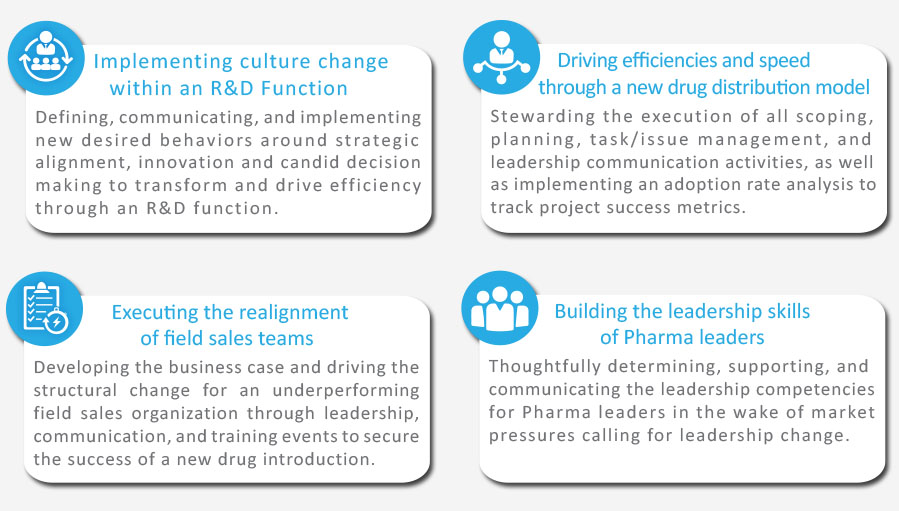PHARMA
LSA recognizes Pharma’s commitment to innovation, scientific productivity, and cultural change. Our project and change management services reduce the stress that is hindering progress.


Client Successes
We share our clients' ambitions. See how our deep expertise and integrated approach have helped clients solve their most complex, highly visible and sometimes unpopular problems.
Changing the Culture of an R&D Function
Business Problem
Client was looking to transform the way the R&D function operated, as defined by the fundamental characteristics of its culture. They had developed a 3-tiered strategy to drive innovation into its worldwide R&D function. They were looking for a trusted and experienced partner to help develop and execute a framework and process to assess, define, enable and sustain the culture required to support the purpose, mission, strategies and values of the function. The function needed to do a better job: 1) De-prioritizing or terminating projects due to uncertain, limited commercial attractiveness and 2) Fully resourcing projects with aligned high scientific and commercial potential. They knew that a contributing factor was in building a culture around being business-minded, open and candid, and aligned.
What We Did
The solution included an initial phase of data gathering, synthesis and communication around this transformation. In the initial phase of work, qualitative investigation and analytics were conducted to understand the current R&D leadership culture and to articulate an execution strategy for the future leadership team. Prior work was leveraged and future work pioneered to get an optimal picture of the new leadership charter. The second component of the project was focused on a group of selected senior leaders to equip them with the knowledge and skills to drive the desired behaviors through the R&D organization, composed of both designed learning experiences for each leadership audience, an individual coaching element, and supplemental training to HR business partners. The third component focused on the measurement approach and success measures associated with the transformation, as well as the insights necessary to sustain these leadership behaviors.
Endowing a Pharma Spinoff with a New Culture and Technology Platform
Business Problem
Global life sciences client was spinning off from its parent company and, at the same time, installing a global implementation of a new ERP system with the goal of incurring minimal impact on the business and on the workforce. The company employed 13,000 employees in global regional headquarters, office locations, manufacturing plants, distribution centers, and public warehouses. They chose to Implement SAP in order to gain corporate independence from parent company. LSA resources made up the change management and training team to ensure the successful adoption of SAP across the newly created company and culture.
What We Did
LSA resources used multiple communication channels to drive the engagement of all global stakeholder groups, including business process owners, future end users and global leaders. We oversaw and coordinated the efforts of a twelve person change management team over the course of the two year implementation. We then assigned training developers to every system module so that process training could be developed directly from newly defined business process procedures. We managed the go-live for different modules and in different regions to ensure that users were both confident and competent in their use of the new system. We worked closely with the client sponsor to use this initiative as a catalyst for the development of a defining culture for the new organization. The initial pilot of specific modules to select countries was very successful; longer term rollout of all modules globally was completed on plan and within the defined budget.
Installing a New Drug Delivery Business Model
Business Problem
Client is a rapidly growing specialty pharmaceutical company that develops and markets medicine through its distribution network. In an effort to gain operational efficiencies and improve speed to market, client was changing its distribution model. Operationalizing the strategy required a program with cross-functional reach, impacting areas in Legal and Compliance, Sales and Marketing, Operations, Distribution, and Analytics. Client was seeking a partner to provide project management services to execute on the strategy. The project management services focused on stakeholder engagement, management of multiple work streams, quick identification of issues, escalation when appropriate, and executive summaries on progress.
What We Did
LSA served in a variety of strategic roles during the implementation of each roll-out phase, including assistance in project scoping and planning, milestone and task management, and issues management and escalation. We participated in and contributed to all project leadership activities and worked with sponsor on communication plans and strategies. We assisted with the adoption rate analyses associated with new distribution channels and tracked all project success metrics throughout the project lifecycle. Finally, we worked with project stakeholders, including vendors as needed, to facilitate project success.
Strategically Aligning a Field Sales Organization
Business Problem
Despite a strong market position in its primary drug category, the Client was under-performing due to inefficient market coverage, an inadequate use of available data, and a sub-optimal sales structure. With the coming launch of a new product in a different, but related, category, there was urgency in rolling out a new field sales alignment that would exploit the leadership position in its core category and better leverage analytics to facilitate a strong launch of its new product. This structural change depended upon a strong communication and change management plan to define the change, the business case underlying the change, the results expected, and the ultimate benefit to each sales professional. LSA was asked to design and deliver change management assistance to the client.
What We Did
LSA provided up-front stakeholder analysis and messaging development to set the stage for a longer-term communication strategy. This work included a clear articulation of the actual organizational changes being made within sales territories and the implications of these changes to currently defined sales teams. The messaging was described in the context of a much larger strategic imperative related to customer-centricity and adaptability. Alignment and sponsorship was generated through a set of leadership webinars that were conducted to get divisional and regional sales leaders driving alignment around these changes and the pending launch.
Building the Leadership Skills of Science Leaders
Business Problem
Internal and external forces across this multi-faceted government health agency created the need for superior leadership with a broader array of leadership competencies. Prior leadership development efforts had been disconnected, inconsistent and not tightly aligned around the competencies most critical to world class leadership performance. Recent environmental events that required effective collaboration across teams, departments, and agencies had further exposed the agency and highlighted this need to more effectively grow and expand the leadership skill set in less conventional, but more impactful, ways.
What We Did
LSA was asked to assess the current state of the agency’s full suite of leadership development capabilities. We defined a strategic vision for agency-wide global leadership development and built out a comprehensive leadership development framework. The framework consisted of a diagnostic dimension that included a literature review, benchmarking, and competency modeling. These diagnostics informed the design of a multi-modal framework for leadership and talent development, evaluation protocols and implementation planning. Related outputs from this work included a crisis leadership competency model specifically associated with catastrophic situations, as well as a leadership immersion program for new science leaders. As a result of this work, the Agency now has a framework whereby future leaders can be assessed, developed and promoted into new areas of responsibility against a defined set of critical leadership behaviors. These new competencies were immediately demonstrated when agency leadership communicated with the national media during a health related crisis.
The First 100 Days – Helping a New CHRO Build a Talent Roadmap
Business Problem
This client was in the process of spinning off from its parent company as a global manufacturer of ethical pharmaceuticals and, in the process, introducing a new CHRO who would need to work with business leaders over the first 100 days to create a workforce strategy. That strategy would need to support the business’ goals, drive performance, and ensure the efficiency and effectiveness of the HR function. Specifically, the client needed assistance in building out a roadmap that covered all critical talent processes, including a three-year plan for the hiring/onboarding, the learning and development, and the retention of talent.
What We Did
LSA was asked to steward the process of capturing critical talent milestones and sequencing along a multi-year roadmap. Key talent process areas included talent retention strategy, employee value proposition (EVP), workforce planning strategy, talent review, talent acquisition, leadership planning, leadership model/framework, leadership development, career architecture, diversity and inclusion, onboarding, culture and engagement, change management, performance management, and workforce analytics. Work effort involved defining Level 1 milestones/mapping all the way down to more granular Level 2 work activities and dates along a 3 year plan.

